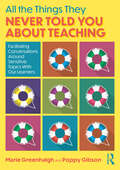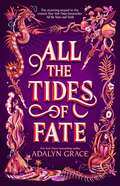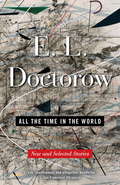- Table View
- List View
All the Things Left Unsaid: Confessions of Love and Regret
by Michael HardingThe new bestseller from the beloved memoirist and Irish Times columnist Michael Harding.For almost fifty years Michael Harding has been crafting words in a bid to express himself and explore truths about the human condition. But even still he found himself unable to say certain things he really wanted to. Then, while in recovery from surgery, he travelled to a cottage on the Atlantic coast and thought again about life and the people who had profoundly affected him; mentors, lovers and old friends.There at the ocean he wrote letters, with an intimacy not previously risked. Letters that were never posted, but that appear now in this audiobook - a vulnerable and beautifully wrought collection of insights into life, death, friendship and love.(P) 2022 Hachette Ireland
All the Things Left Unsaid: Confessions of Love and Regret
by Michael HardingNUMBER ONE BESTSELLER'A beautiful book of great tenderness, love of life, and wisdom' JOSEPH O'CONNORFor almost fifty years, Michael Harding has been crafting words in a bid to express himself and to explore truths about the human condition. But even still he found himself unable to say certain things he really wanted to. Then, while in recovery from surgery, he travelled to a cottage on the Atlantic coast and thought again about life and the people who had profoundly affected him over the years: mentors, loves and old friends.There at the ocean he wrote letters, with an intimacy not previously risked. Letters that would never be posted but that appear now in All the Things Left Unsaid - a vulnerable and beautifully wrought collection of insights into life, death, friendship and love.PRAISE FOR MICHAEL HARDING'S BOOKSHilarious, and tender ... and always beautifully written' Kevin Barry'Often funny, occasionally disturbing ... Harding has peeled back his soul and held it out on the palm of his hand for all to see' Christine Dwyer Hickey'It's rare for a memoir to demand such intense emotional involvement and rarer still for it to be so fully rewarded' The Sunday Times 'Searingly honest ... Harding's narrative seems to rest on the pulse of Ireland' The Irish Times
All the Things Mom Will Never Say (All the Things)
by Noé CarlainA silly and funny anthology of things a mom will never ever tell her child! Don't go to bed so early! You have school tomorrow. Said no mother ever! Can you imagine your mom saying this or suggesting you don't need to use a tissue when you could use your sleeve instead. In this comical look at all the things a mom is never likely to say, kids and parents alike will laugh out loud at what might happen if Mom stops being Mom. She'll never encourage you to stop reading or eating your vegetables. But kids know they can always count on mom to always want a kiss and hug. So get ready for story time reading to get a little silly with these hilarious everyday sentences that are the exact opposite of what you would expect a mom to repeat.
All the Things My Grandpa Has Done
by Noé Carlain Ronan BadelOther titles in the series have sold well: All the Things a Dad Will Always Say (789 copies), All the Things a Mom Will Never Say (456 copies), All the Things Santa Claus Will Never Do (1,134 copies with review in SLJ), and All the Things a Teacher Will Never Say (455 copies) According to KidsHealth.org, "A good sense of humor is a tool that kids can rely on throughout life to help them: -see things from many perspectives other than the most obvious be spontaneous -grasp unconventional ideas or ways of thinking -see beyond the surface of things -enjoy and participate in the playful aspects of life -not take themselves too seriously"
All the Things Santa Claus Will Never Do
by Noé Carlain Ronan BadelImagining Santa Claus in a number of worst-case scenarios shows children that everything may not always go as planned, but Christmas magic will always prevailParents and children will add laughter to their Christmas tradition with a story that reassures them that they'll never be forgottenColorful, silly illustrations depicting Santa in hilarious situations such as taking a selfie with his reindeer enhance the fun and encourage holiday spirit
All the Things That Could Go Wrong
by Stewart FosterThere are two sides to every story.Alex's OCD is so severe that some days it is difficult for him to even leave his house. His classmate Dan is so angry that he lashes out at the easiest target he can find at school-Alex. When their moms arrange for the two classmates to spend time together over winter break, it seems like a recipe for certain disaster...until it isn't. Once forced together these two sworn enemies discover that there is much more to each of them than they ever knew. Alex is so much more than his condition, and Dan is more than just an angry bully.
All the Things They Never Told You About Teaching: Facilitating Conversations Around Sensitive Topics With Our Learners
by Poppy Gibson Marie GreenhalghMany teachers do not feel confident in their role, particularly as they are increasingly expected to address topics with their pupils that they feel ill-equipped to deal with. Co-authored by two highly experienced educators, All The Things They Never Told You About Teaching is an essential guide, supporting teachers in navigating those tricky, taboo subjects that sit outside of the national curriculum and may not have been fully explored during their teacher training.Each chapter unpacks and addresses a range of ‘myths’ and ‘truths’ behind these subjects in an accessible manner, helping teachers to develop their understanding and facilitate compassionate conversations about these topics. This includes, but is not limited to: Mental health Bullying Neurodiversity Gender diversity Sex and relationships Climate crisis A must read for anyone working in education, this book guides educators through sensitively addressing difficult topics within the classroom, creating a more compassionate and supportive learning environment for all.
All the Things They Said We Couldn't Have: Stories of Trans Joy
by Tash Oakes-Monger'Transition has not been something linear for me, my joy has come in seasons.'Now, more than ever, trans people deserve to hear stories of joy and hope, where being trans doesn't have to be defined by fear and dysphoria, but can be experienced through courage, freedom, and the love and acceptance of their chosen families.Through a series of uplifting, generous and beautifully crafted vignettes, T. C. Oakes-Monger gently leads you through the cycle of the seasons - beginning in Autumn and the shedding of leaves and identity, moving through the darkness of Winter, its cold days, and the reality of daily life, into Spring, newness, and change, and ending with the joy of long Summer days and being out and proud - and invites you to find similar moments of joy in your life.Celebratory and empowering, these stories are a reminder of the power joy can bring.
All the Things We Didn't Say: Two Memoirs (Willie Morris Books in Memoir and Biography)
by Marion Garrard Barnwell Mary DuBose ClarkIn this poignant and introspective dual memoir, Marion Garrard Barnwell embarks on a deeply personal journey. Inspired by the memoir of her maternal grandmother, Mary DuBose Trice Clark, affectionately known as “Ganny,” the narratives, though separated by decades, are brought together to offer readers a unique and moving exploration of growing up in Mississippi and the intersections of family, motherhood, and self-discovery. Clark’s memoir, penned in 1956, offers readers a glimpse into the past, telling the story of her life in Mississippi with unwavering commitment to “just plain facts.” Her narrative traverses the landscapes of Okalona, Nettleton, Verona, and Tupelo, revealing their histories and the vibrant tapestry of her life while artfully sidestepping the complexities of her relationships and emotional vulnerabilities. Reflecting on an era when discussions of emotion and self-awareness were often shrouded in reticence, Clark’s story leaves a void in which Barnwell seeks to uncover the unspoken truths that shaped their family dynamics. Written at the age of seventy-seven, the same age as her grandmother when she wrote her memoir, Barnwell’s writing emerges as a response to the enigmatic silence within her grandmother’s narrative. It paints a vivid and expansive picture of her own life in the Mississippi Delta while also addressing profound themes of alcoholism, racism, shared family history, and the intricate dynamics between generations of women. As Barnwell weaves her own memoir into the fabric of this book, she takes readers on her emotional journey of self-discovery and truth-telling that leads to healing. All the Things We Didn’t Say: Two Memoirs is a testament to the power of storytelling and a captivating ode to the enduring human spirit and the timeless pursuit of understanding the intricate threads that connect us across generations.
All the Things We Do in the Dark
by Saundra MitchellSadie meets Girl in Pieces in this dark, emotional thriller by acclaimed author Saundra Mitchell.Something happened to Ava. The curving scar on her face is proof. Ava would rather keep that something hidden—buried deep in her heart and her soul.But in the woods on the outskirts of town, the traces of someone else’s secrets lie frozen, awaiting Ava’s discovery—and what Ava finds threatens to topple the carefully constructed wall of normalcy that she’s spent years building around her.Secrets leave scars. But when the secret in question is not your own—do you ignore the truth and walk away? Or do you uncover it from its shallow grave and let it reopen old wounds—wounds that have finally begun to heal?
All the Things We Don't Talk About
by Amy FeltmanA &“big-hearted, lively, and expansive portrait of a family&” that follows a neurodivergent father, his nonbinary teenager, and the sudden, catastrophic reappearance of the woman who abandoned them (Claire Lombardo, New York Times bestselling author).Morgan Flowers just wants to hide. Raised by their neurodivergent father, Morgan has grown up haunted by the absence of their mysterious mother Zoe, especially now, as they navigate their gender identity and the turmoil of first love. Their father Julian has raised Morgan with care, but he can&’t quite fill the gap left by the dazzling and destructive Zoe, who fled to Europe on Morgan&’s first birthday. And when Zoe is dumped by her girlfriend Brigid, she suddenly comes crashing back into Morgan and Julian&’s lives, poised to disrupt the fragile peace they have so carefully cultivated.Through it all, Julian and Brigid have become unlikely pen-pals and friends, united by the knowledge of what it&’s like to love and lose Zoe; they both know that she hasn&’t changed. Despite the red flags, Morgan is swiftly drawn into Zoe&’s glittering orbit and into a series of harmful missteps, and Brigid may be the only link that can pull them back from the edge. A story of betrayal and trauma alongside queer love and resilience, ALL THE THINGS WE DON&’T TALK ABOUT is a celebration of and a reckoning with the power and unintentional pain of a thoroughly modern family.
All the Things We Found
by Joanne LevyRuthie is finally getting used to the new normal: her parents' divorce, having a stepdad and (annoying) stepbrothers and trying not to think too much about before. When her mom starts feeling sick, Ruthie’s relieved it’s nothing serious…until her mom tells her she’s pregnant again. Their family suffered a loss three years ago and it was devastating. How could her mom risk that again? At least Ruthie has her best friend and her dog to help comfort her, as well as her favorite book series that always cheers her up: The Unicorns of Faravelle Forest. When Ruthie unexpectedly meets Ally, an older woman in the park where she takes her dog to play, she learns Ally is grieving a loss too, and the two develop an unlikely friendship. Though the journey is never smooth, Ruthie eventually realizes there’s comfort to be found in expressing your feelings and cherishing the memory of those you've loved. The epub edition of this title is fully accessible. Praise for Joanne Levy: ★ "A heartfelt and expertly written tale of loss, family, and friendship that will have readers blinking back their tears...Beautiful and sincere."—Kirkus Reviews, starred review for Sorry for Your Loss
All the Things We Never Knew
by Liara Tamani“Tamani masterfully bounces and slams two hearts up and down a shrouded court of first love and revelations. A hard-to-put-down backboard-breaker.”—Rita Williams-Garcia, National Book Award Finalist and New York Times–bestselling author From the moment Carli and Rex first locked eyes on a Texas high school basketball court, they both knew it was destiny. But can you truly love someone else if you don’t love yourself? Acclaimed author Liara Tamani’s luminous second novel explores love, family, heartbreak, betrayal, and the power of healing, in gorgeous prose that will appeal to readers of Nicola Yoon and Jacqueline Woodson. A glance was all it took. That kind of connection, the immediate and raw understanding of another person, just doesn’t come along very often. And as rising stars on their Texas high schools’ respective basketball teams, destined for bright futures in college and beyond, it seems like a match made in heaven. But Carli and Rex have secrets. As do their families.Liara Tamani, the author of the acclaimed Calling My Name, follows two Black teenagers as they discover how first love, heartbreak, betrayal, and family can shape you—for better or for worse. A novel full of pain, joy, healing, and hope for fans of Elizabeth Acevedo, Jacqueline Woodson, and Jenny Han. “A beautifully poignant love letter: to a first love, to basketball, and to that enigmatic bunch we think we know best, only to discover we don’t know at all—family. Tamani’s latest is a bright shining star.”—David Arnold, New York Times–bestselling author of Mosquitoland
All the Things We Never Knew: Chasing the Chaos of Mental Illness
by Sheila HamiltonA reporter chases the biggest story of her life-her husband's descent into mental illness.Even as a reporter, Sheila Hamilton missed the signs as her husband David's mental illness unfolded before her. By the time she had pieced together the puzzle, it was too late. Her once brilliant, intense, and passionate partner was dead within six weeks of a diagnosis of bipolar disorder, leaving his nine-year-old daughter and wife without so much as a note to explain his actions, a plan to help them recover from their profound grief, or a solution for the hundreds of thousands of dollars in debt that they would inherit from him.All the Things We Never Knew takes readers from David and Sheila's romance through the last three months of their life together and into the year after his death. It details their unsettling descent from ordinary life into the world of mental illness, and examines the fragile line between reality and madness. Now, a decade after David's death, Sheila and her daughter, Sophie, have learned the power of choosing life over retreat; let themselves love and trust again; and understand the importance of forgiveness. Their story will resonate with all those who have loved someone who suffers from mental illness.
All the Things We Never Said
by Yasmin RahmanSixteen-year-old Mehreen is overwhelmed by her anxiety and depression, and she doesn't believe anyone in her life will understand if she tries to talk about it. She's been thinking about suicide for a while when she discovers a website called MementoMori.com. The site matches people with partners and assigns them a date on which to end their lives, together. Mehreen is partnered with Cara and Olivia, strangers dealing with their own struggles. But as the girls get to know one another in preparation for their "date of termination" they find themselves developing a strong bond—even becoming friends. For the first time, they're each able to share their darkest secrets with people who won't judge them. They realize that, with the right support systems, life is worth living after all. So they decide to abandon the suicide pact. Except the website won't let them stop. As their assigned "date of termination" draws nearer and MementoMori continues to manipulate them, the girls will have to rely on one another to survive. If you or a loved one is experiencing suicidal thoughts, call or text 988 to reach the Suicide and Crisis Lifeline for free, confidential 24/7 support.
All the Things You Are
by Courtney SheinmelTwelve-year-old Carly Wheeler lives a charmed life. Her mother is a stylist for the soap opera Lovelock Falls, she lives in a nice house, and she goes to an excellent private school. But when Carly's mom is arrested and charged with embezzlement, everything starts to unravel. There are shocking stories about her mother's crimes in the local newspaper. Carly's friends start avoiding her. And her stepfather starts worrying about money. How can Carly put her life back together when it feels like she's missing all the pieces?
All the Things You Will Do!
by Lucy RowlandShow children they can be everything they dream of with this inspiring picture book all about the promise life brings!You might climb the highest mountain,you might face the wind and snow.You might read a hundred booksand then teach others all you know.This inspiring new book combines aspiration, fun, and heartwarming moments to show children that they really can be everything they hope to be... and more! With energetic text and bright, bold illustrations, Lucy Rowland and Neely Daggett are a dynamite team. Filled with energy and heart, this is a beautiful book for family sharing and fans of I've Loved You Since Forever and The Wonderful Things You Will Be.
All the Things a Teacher Will Never Say (All the Things)
by Noé CarlainA laugh-out-loud anthology of all the things a teacher will never tell her students to do in the classroom! No math today; it's too hard! Said no teacher ever! Can you imagine your teacher saying this or suggesting you keep your gum and not to forget to stick it under the desk? In this comical look at all the things a teacher is never likely to say, kids, parents, and educators alike will laugh out loud at what might happen if the school day was turned upside down. While your teacher will never encourage you to paint on your desk or copy your neighbor's paper, kids know they can always count on the teacher to make learning fun. So even if things may not always go as planned, structure and boundaries create a safe space, and one thing is always for sure—a teacher will always miss her students at the end of the day.
All the Things: A 30 Day Guide to Experiencing God's Presence in the Prayer of Examen
by Katie Haseltine“A winsome invitation to grow your soul through a deeper exploration of Ignatian spirituality [and] contemplative living” (Hunter Mobley, author of Forty Days on Being a Two).In All the Things: A 30 Day Guide to Experiencing God’s Presence in the Prayer of Examen, Katie reveals what happened when she opened herself up to an ancient prayer practice popularized by a sixteenth-century warrior turned priest named St. Ignatius. She found in the Ignatian Examen that she already possessed everything she needed to know and love God. It was all right there in the everyday stuff of her ordinary and messy life.All the Things includes thirty readings that show you the numerous ways the prayer of Examen can impact and transform your life one day at a time. If you long for a deeper awareness of God’s presence, a sense of companionship with Jesus, and a felt experience of the love of God—without wearing yourself out trying to find it—join Katie to learn more about this life-changing and life-giving prayer.
All the Tides of Fate (All the Stars and Teeth Duology #2)
by Adalyn GraceThe thrilling sequel to instant New York Times bestseller All the Stars and Teeth, called “captivating” by Tomi Adeyemi, “Vicious and alluring” by Hafsah Faizal, and “phenomenal” by Adrienne Young. Now author Adalyn Grace is back with more high seas adventure in All the Tides of Fate, this electrifying fantasy, perfect for fans of Stephanie Garber’s Caraval and Sarah J. Maas’s Throne of Glass series.Through blood and sacrifice, Amora Montara has conquered a rebellion and taken her rightful place as queen of Visidia. Now, with the islands in turmoil and the people questioning her authority, Amora cannot allow anyone to see her weaknesses.No one can know about the curse in her bloodline. No one can know that she’s lost her magic. No one can know the truth about the boy who holds the missing half of her soul. To save herself and Visidia, Amora embarks on a desperate quest for a mythical artifact that could fix everything—but it comes at a terrible cost. As she tries to balance her loyalty to her people, her crew, and the desires of her heart, Amora will soon discover that the power to rule might destroy her.An Imprint BookPraise for All the Stars and Teeth: “Jam-packed with swashbuckling adventure, swoonworthy romance, and dark, lush magic.” - Christine Lynn Herman, author of The Devouring Gray “If an epic sea fantasy filled with strange pirates and vengeful mermaids speaks to your interests, well…we may have found your favorite book ever....a tale of magic and second chances that’s fresh and thrilling in equal measure.” –Entertainment WeeklyOne of Buzzfeed's "Most Anticipated YA Books of 2020"
All the Time We Need
by Megan DanielTime travel romance spannning from 1993 New York/New Orleans to 1858 New Orleans.
All the Time in the World
by E. L. DoctorowFrom Ragtime and Billy Bathgate to World's Fair, The March, and Homer & Langley, the fiction of E. L. Doctorow comprises a towering achievement in modern American letters. Now Doctorow returns with an enthralling collection of brilliant, startling short fiction about people who, as the author notes in his Preface, are somehow "distinct from their surroundings--people in some sort of contest with the prevailing world". A man at the end of an ordinary workday, extracts himself from his upper-middle-class life and turns to foraging in the same affluent suburb where he once lived with his family. A college graduate takes a dishwasher's job on a whim, and becomes entangled in a criminal enterprise after agreeing to marry a beautiful immigrant for money. A husband and wife's tense relationship is exacerbated when a stranger enters their home and claims to have grown up there. An urbanite out on his morning run suspects that the city in which he's lived all his life has transmogrified into another city altogether. These are among the wide-ranging creations in this stunning collection, resonant with the mystery, tension, and moral investigation that distinguish the fiction of E. L. Doctorow. Containing six unforgettable stories that have never appeared in book form, and a selection of previous Doctorow classics, All the Time in the World affords us another opportunity to savor the genius of this American master.From the Hardcover edition.
All the Time in the World
by Jessica Kerwin JenkinsEntertaining, unexpected, and full of charm, the follow-up to Jessica Kerwin Jenkins's Encyclopedia of the Exquisite presents a miscellany of engaging stories, detailing the intriguing customs, traditions, and guilty pleasures pursued throughout the ages. All the Time in the World takes its cue from an iconic component of medieval life, the book of hours, which prescribed certain readings and contemplations for certain parts of the day throughout the year. Divided into more than seventy-five entries, All the Time in the World is brimming with witty bons mots, interesting etymologies, and arresting anecdotes encompassing an array of cultures and eras. Subjects covered include the daylong ceremony of laying a royal Elizabethan tablecloth; the radicalization of sartorial chic in 1890s Paris; Nostradamus's belief in the aphrodisiac power of jam; the sensuous practice of sniffing incense in fifteenth-century Japan; the American fascination with flaming desserts; the short-lived artistic discipline of "lumia," or visual music; the evolution of coffee from a religious ritual to a forbidden delight in the Middle East; Henriette d'Angeville's fearless and wine-fueled ascent of Mont Blanc; the elaborate treasure hunts concocted by London's Bright Young Things; and the musical revolution known as bebop. An antidote to the contemporary cult of "getting things done," All the Time in the World revives forgotten treasures of the past while inspiring a passion for good living in the present.From the Hardcover edition.
All the Time in the World (John Gierach's Fly-fishing Library)
by John GierachDiscover the answer to life&’s most pressing problems through the joy of fly-fishing from master philosopher John Gierach, &“the dean of fly-fishing&” (Kirkus Reviews), who is &“arguably the best fishing writer working&” (The Wall Street Journal).Once again, John Gierach tells the world why the pastime of fly-fishing makes so much sense—except when it doesn&’t. In this &“shrewd, perceptive, and wryly funny&” (The Wall Street Journal) book, he recalls the joys of landing that trout he&’s been watching for the last hour—and then losing an even fatter one a little later. Joy and frustration mix in Gierach&’s latest appreciation of the fly-fishing life as he takes us from his home waters on the Front Range of the Rockies in Colorado to the fishing meccas all over North America. From fishing lodges in Alaska to memories of the local creek in the Midwest where he grew up, Gierach celebrates the indispensability of the natural world around us.
All the Time in the World: A Novel
by Caroline AngellAn unforgettable debut about a young woman's choice between the future she's always imagined and the people she's come to love.Charlotte, a gifted and superbly trained young musician, has been blindsided by a shocking betrayal in her promising career when she takes a babysitting job with the McLeans, a glamorous Upper East Side Manhattan family. At first, the nanny gig is just a way of tiding herself over until she has licked her wounds and figured out her next move as a composer in New York. But, as it turns out, Charlotte is naturally good with children and becomes as deeply fond of the two little boys as they are of her. When an unthinkable tragedy leaves the McLeans bereft, Charlotte is not the only one who realizes that she's the key to holding little George and Matty's world together. Suddenly, in addition to life's usual puzzles, such as sorting out which suitor is her best match, she finds herself with an impossible choice between her life-long dreams and the torn-apart family she's come to love. By turns hilarious, sexy, and wise, Caroline Angell's remarkable and generous debut is the story of a young woman's discovery of the things that matter most.
























